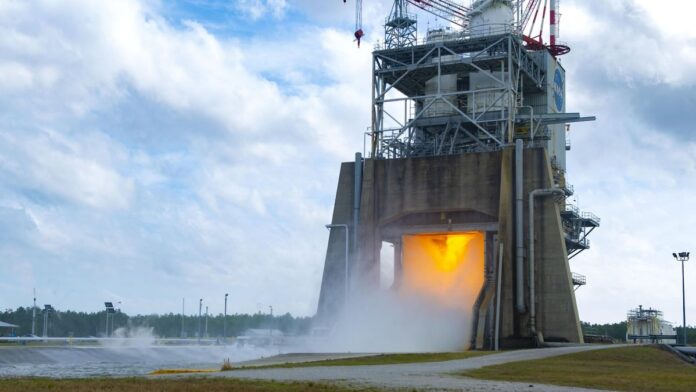NASA engineers have hot-fired the redesigned Artemis moon rocket in preparation for future Space Launch System (SLS) flights that will take humanity back to the moon and beyond.
The test of the RS-25 engine was conducted at the Fred Haise Test Stand located at NASA’s Stennis Space Center near Bay St. Louis, Mississippi, on Wednesday, Feb. 22. The test is part of a series to support the production of the new RS-25 engines by contractor Aerojet Rocketdyne, the lead Space Launch System engine contractor.
The improved engines are expected to power future Artemis program missions beginning with Artemis 5. Four of these engines were fire simultaneously during the test, generating as much as 2 million pounds of thrust that will one day be used to help launch crewed Artemis missions to the moon.
Related: NASA test fires upgraded rocket engines for future Artemis moon missions (video)
During the test on Wednesday, the RS-25 engine was fired up to a power level of 111%, the same amount of power that would be needed by the SLS to lift the Artemis mission crew module, Orion, and secondary payloads to orbit. NASA fired the engine for 600 seconds, which is 500 seconds longer than the SLS needs to lift the Orion craft and additional payloads to space, the agency wrote in a statement (opens in new tab).
The reason for this long-duration hot fire is to allow operators of the RS-25 to test the limits of the engine’s performance. This helps provide a safety margin for actual flight operations.
The engines on the SLS currently are upgrades of 16 remaining main engines that remained at the conclusion of NASA’s space shuttle program. NASA Stennis began testing the engines in 2015, adding modifications that would be required to fly SLS, the most powerful rocket ever to launch.
One of the most impressive aspects of the SLS is the fact is it is designed to be upgradable. With this in mind, in 2019, NASA contracted Aerojet Rocketdyne to produce completely new RS-25 engines for SLS missions beyond Artemis 4.
Created with advanced manufacturing techniques such as 3D printing that reduced the cost and timescale of development, the engines hit initial developmental testing in 2020.
On Feb. 8, the first real test of the first completed upgraded RS-25 engine was conducted as part of a 12-test program which will ensure Aerojet Rocketdyne is ready to produce the engines for future missions. Each of these subsequent engines will be tested at NASA Stennis by a combined team of NASA, Aerojet Rocketdyne, and Syncom Space Services operators.
Follow us on Twitter @Spacedotcom (opens in new tab) or on Facebook (opens in new tab).

